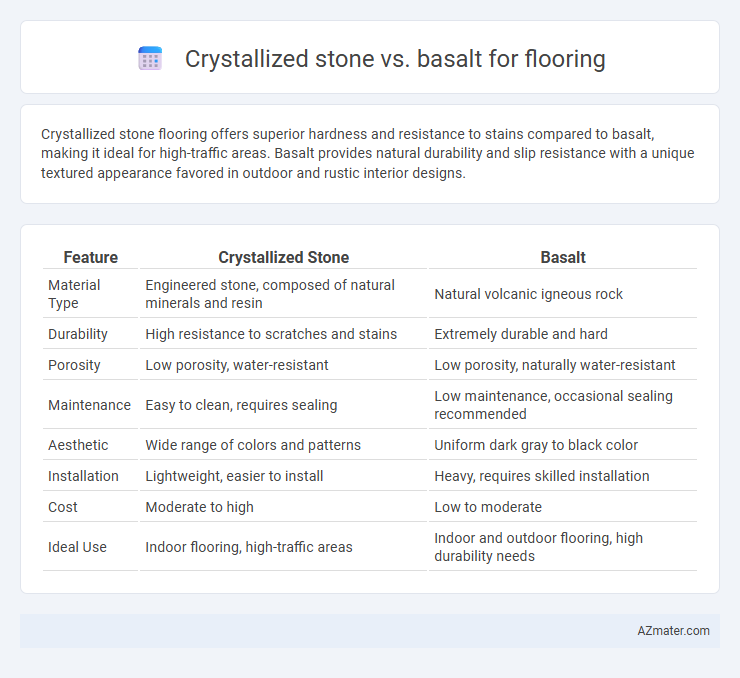Crystallized stone flooring offers superior hardness and resistance to stains compared to basalt, making it ideal for high-traffic areas. Basalt provides natural durability and slip resistance with a unique textured appearance favored in outdoor and rustic interior designs.
Table of Comparison
| Feature | Crystallized Stone | Basalt |
|---|---|---|
| Material Type | Engineered stone, composed of natural minerals and resin | Natural volcanic igneous rock |
| Durability | High resistance to scratches and stains | Extremely durable and hard |
| Porosity | Low porosity, water-resistant | Low porosity, naturally water-resistant |
| Maintenance | Easy to clean, requires sealing | Low maintenance, occasional sealing recommended |
| Aesthetic | Wide range of colors and patterns | Uniform dark gray to black color |
| Installation | Lightweight, easier to install | Heavy, requires skilled installation |
| Cost | Moderate to high | Low to moderate |
| Ideal Use | Indoor flooring, high-traffic areas | Indoor and outdoor flooring, high durability needs |
Introduction to Crystallized Stone and Basalt Flooring
Crystallized stone flooring offers enhanced durability and a polished, luxurious aesthetic, combining natural stone with engineered technology for improved strength and resistance to scratches and stains. Basalt flooring is known for its volcanic origin, providing exceptional hardness, thermal resistance, and a unique dark tone that adds a modern, earthy appeal to interiors. Both materials deliver long-lasting performance, with crystallized stone excelling in design versatility, while basalt stands out for its robust nature and heat retention properties.
Formation and Composition of Crystallized Stone
Crystallized stone forms through a high-temperature sintering process that fuses natural minerals into a dense, non-porous surface, combining quartz, feldspar, and kaolin clay to create enhanced hardness and durability. Basalt, in contrast, is a volcanic igneous rock composed primarily of plagioclase and pyroxene minerals, formed from the rapid cooling of lava at the earth's surface. The engineered composition of crystallized stone offers superior resistance to scratches and stains compared to the naturally occurring mineral matrix of basalt.
Geological Origins and Properties of Basalt
Basalt, an extrusive igneous rock formed from the rapid cooling of lava at the Earth's surface, is characterized by its fine-grained texture and high density, making it exceptionally durable for flooring applications. In contrast to crystallized stone, which typically exhibits a visible crystalline structure due to slow cooling beneath the surface, basalt's homogenous composition offers superior resistance to wear, staining, and thermal shock. Its natural dark coloration and strength stem from rich mineral content like pyroxene and plagioclase, providing both aesthetic appeal and structural integrity in high-traffic flooring environments.
Appearance and Aesthetic Differences
Crystallized stone flooring features a glossy, glass-like finish with intricate, colorful patterns created through high-temperature vitrification, offering a contemporary and luxurious look. Basalt flooring presents a matte or honed surface with a uniform dark gray to black color, emphasizing natural, understated elegance and a sleek, modern aesthetic. The visual appeal of crystallized stone is vibrant and dynamic, while basalt provides a more subdued, minimalistic style suitable for industrial or rustic interiors.
Durability and Hardness Comparison
Crystallized stone flooring offers exceptional hardness with a Mohs scale rating typically between 6.5 to 7.5, making it highly resistant to scratches and wear over time. Basalt flooring is known for its superior durability and hardness, often rated around 7 on the Mohs scale, providing excellent resistance to heavy foot traffic and impact. Both materials are durable, but basalt's natural density and volcanic origin contribute to slightly better resistance against chipping and cracking compared to crystallized stone.
Maintenance and Cleaning Requirements
Crystallized stone flooring demands minimal maintenance due to its high density and impermeability, resisting stains and scratches effectively with just regular sweeping and occasional damp mopping. Basalt flooring, while durable and tough, requires sealing to prevent moisture penetration and periodic reapplication of sealant to maintain its stain resistance and appearance. Both materials benefit from pH-neutral cleaners, but basalt's natural porosity makes it slightly more labor-intensive to clean and maintain compared to crystallized stone.
Slip Resistance and Safety Factors
Crystallized stone offers superior slip resistance due to its textured surface, making it a safer option for wet or high-traffic areas compared to the often smoother finish of basalt. Basalt, while durable and visually appealing, can become slippery when polished, potentially posing safety risks without proper surface treatment. Selecting crystallized stone flooring enhances safety with its natural grip, reducing the likelihood of slips and falls in residential or commercial environments.
Installation Techniques and Costs
Crystallized stone flooring requires a specialized installation process involving precise cutting and adhesive application to ensure a seamless finish, typically demanding skilled labor and higher upfront costs. Basalt flooring installation involves straightforward techniques such as dry laying or thin-set mortar application, making it more cost-effective and accessible for standard construction projects. The overall cost comparison favors basalt due to lower material and labor expenses, while crystallized stone offers a premium look at a higher price point and installation complexity.
Environmental Impact and Sustainability
Crystallized stone flooring often involves energy-intensive manufacturing processes and chemical treatments, which can increase its environmental footprint compared to basalt. Basalt, a natural volcanic rock, offers superior sustainability due to its abundance, natural formation, and minimal processing requirements, resulting in lower carbon emissions and reduced waste. Choosing basalt flooring supports eco-friendly construction practices by utilizing a durable, recyclable material with a smaller impact on natural resources.
Choosing the Right Material for Your Flooring Needs
Crystallized stone offers a high-gloss finish with exceptional hardness, making it ideal for areas requiring durability and scratch resistance in flooring. Basalt provides a natural, matte texture with excellent thermal insulation and slip resistance, suitable for both indoor and outdoor applications. Selecting between crystallized stone and basalt depends on your preference for aesthetic appeal, maintenance requirements, and specific environmental conditions of the flooring space.

Infographic: Crystallized stone vs Basalt for Flooring
 azmater.com
azmater.com